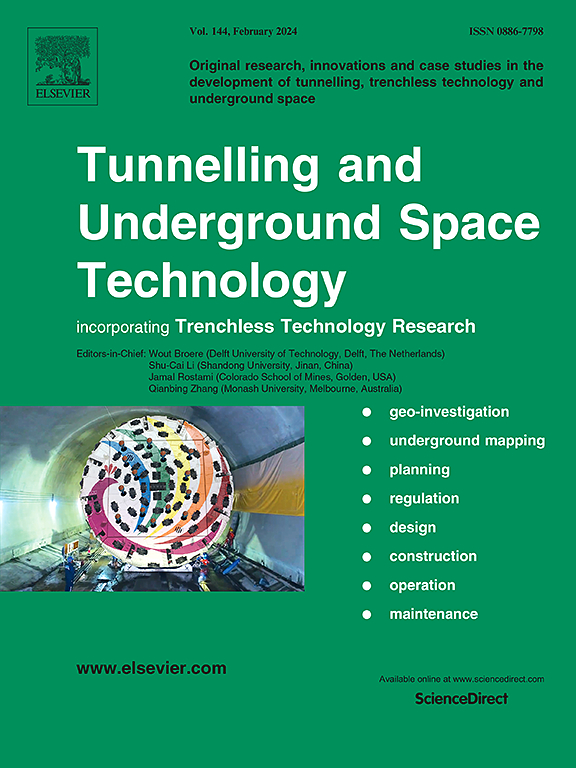Deep learning-based point cloud semantic segmentation for tunnel face excavation areas in drilling and blasting tunnels
IF 6.7
1区 工程技术
Q1 CONSTRUCTION & BUILDING TECHNOLOGY
引用次数: 0
Abstract
The tunnel face excavation area in drilling and blasting tunnels contains rich construction and geological information, with each part requiring unique measurement indicators and analysis. Precise segmentation of these components is urgently needed to enable automated measurement. This paper proposes a deep learning-based point cloud semantic segmentation method to automatically and accurately segment different parts of the tunnel face excavation area during the construction phase of drilling and blasting tunnels. First, point cloud data of the excavation area were collected and labeled the tunnel face, excavation profile, ground surface, and initial support section. A sample dataset was then created by calculating normal vectors, applying the synthetic minority oversampling technique (SMOTE), and using data augmentation techniques. A point cloud semantic segmentation network was subsequently constructed and trained, and its performance was subsequently evaluated using metrics such as training accuracy, testing accuracy, mean intersection over union (mIoU), and confusion matrices. The experimental results demonstrate that the proposed method achieves high-precision semantic segmentation in the complex, irregular tunnel face area of drilling and blasting tunnels, with a maximum training accuracy of 0.9854, a validation accuracy of 0.9536, a testing accuracy of 0.9551, and all mIoU values above 0.91. The discussion examines the impact of normal vector features and data augmentation on model performance and demonstrates that data augmentation enhances training effectiveness and generalizability. These findings suggest that the proposed method has substantial potential for automated measurement in drilling and blasting tunnel construction.
基于深度学习的钻爆隧道工作面开挖区域点云语义分割
钻爆隧道的巷道工作面开挖区域包含着丰富的施工和地质信息,每个部分都需要独特的测量指标和分析。为了实现自动化测量,迫切需要对这些组件进行精确分割。提出了一种基于深度学习的点云语义分割方法,在钻爆隧道施工阶段自动准确分割巷道开挖区域的不同部分。首先,采集开挖区域点云数据,对巷道工作面、开挖剖面、地表和初始支护断面进行标记;然后通过计算法向量、应用合成少数过采样技术(SMOTE)和使用数据增强技术创建样本数据集。随后构建并训练了一个点云语义分割网络,并使用训练精度、测试精度、平均交联(mIoU)和混淆矩阵等指标对其性能进行了评估。实验结果表明,该方法在钻爆巷道复杂、不规则的巷道面区域实现了高精度的语义分割,最大训练精度为0.9854,验证精度为0.9536,测试精度为0.9551,mIoU值均在0.91以上。讨论探讨了法向量特征和数据增强对模型性能的影响,并证明了数据增强可以提高训练效率和泛化性。这些结果表明,该方法在钻爆隧道施工自动化测量方面具有很大的潜力。
本文章由计算机程序翻译,如有差异,请以英文原文为准。
求助全文
约1分钟内获得全文
求助全文
来源期刊

Tunnelling and Underground Space Technology
工程技术-工程:土木
CiteScore
11.90
自引率
18.80%
发文量
454
审稿时长
10.8 months
期刊介绍:
Tunnelling and Underground Space Technology is an international journal which publishes authoritative articles encompassing the development of innovative uses of underground space and the results of high quality research into improved, more cost-effective techniques for the planning, geo-investigation, design, construction, operation and maintenance of underground and earth-sheltered structures. The journal provides an effective vehicle for the improved worldwide exchange of information on developments in underground technology - and the experience gained from its use - and is strongly committed to publishing papers on the interdisciplinary aspects of creating, planning, and regulating underground space.
 求助内容:
求助内容: 应助结果提醒方式:
应助结果提醒方式:


